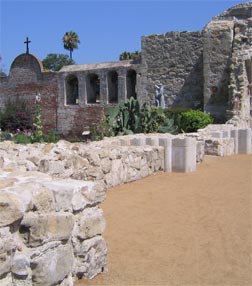Take a Walk Through San Juan Capistrano
Family Motor Coaching Magazine By Kathy Sartori
Some might picture San Juan Capistrano, California, as a wistful town anchored in the past. And why not? Nestled among the tawny hills, strawberry farms, and eucalyptus trees, it is the home of the famed 1776 Mission San Juan Capistrano–the “Jewel of the Missions.” But that is only part of the story. The town also offers visitors a chance to explore unusual shops, enjoy live entertainment, and choose from numerous top-notch eateries.
But first, visitors should explore the historical mission site, resplendent with aging weeping willows, stately palm trees, koi ponds topped with flowering lily pads, lush rose gardens, and cactus displays. And they can retrace history as they meander through the mission’s ancient rooms and see excavations that reveal how padres and Acjachemen Indians lived and worked.
 The mission was actually founded twice. Father Fermin Lasuen began a mission on the site in 1775, but work stopped after only eight days when the crew learned of an attack on the San Diego Mission and returned there for shelter. A year later, Father Juniperro Serra and a military escort returned to the San Juan Capistrano site and restarted the work in earnest. First they built the Serra Chapel (in 1777); it is now the only remaining edifice where Father Serra is known to have said Mass. Its early Indian design is enchanting, and its altar gleams with gold.
The mission was actually founded twice. Father Fermin Lasuen began a mission on the site in 1775, but work stopped after only eight days when the crew learned of an attack on the San Diego Mission and returned there for shelter. A year later, Father Juniperro Serra and a military escort returned to the San Juan Capistrano site and restarted the work in earnest. First they built the Serra Chapel (in 1777); it is now the only remaining edifice where Father Serra is known to have said Mass. Its early Indian design is enchanting, and its altar gleams with gold.
A larger church on the site was destroyed by an earthquake in 1812, and only the wall behind the altar still stands. Three bells from that period hang in a bell wall, and they can be heard on special occasions.
San Juan Capistrano is the seventh in a chain of 21 missions established on El Camino Real (the King’s Highway) in California. Spanish priests Christianized the local Indians and taught them to produce animal hides, tallow, citrus fruits, wines, and olives. One room in the mission complex offers a short historical movie; others contain displays of clothing and artifacts from Indians’ and padres’ living quarters. An array of contemporary and European art, tucked away in another room, will delight you as well.
To many, the mission is best known for the community of swallows that call it home between March and October. Most of the birds return each year on March 19 or a few days before. To honor their arrival, the mission hosts a Return of the Swallows Celebration. This year’s events will take place Saturday and Sunday, March 15 and 16 (the weekend before the start of “California Dreamin’” convention) and on Wednesday, March 19, for the traditional observance. Festivities include the ringing of the mission bells at the sight of the first swallows; live music; dance groups; craft demonstrations; and tasty ethnic foods. Activities will take place at the mission from 8:30 a.m. to 5:00 p.m. each day.
This festival is held in addition to regularly scheduled events that occur at the mission throughout the year. Living History Days, during which visitors can talk to authentically costumed artisans and historical characters of the 16th and 17th century, takes place the second Saturday of each month. You’ll meet a bona fide blacksmith here, too- San Juan Capistrano was the only California mission where iron-smelting took place, and the 18th-century furnaces are still on the grounds. Antique iron hinges, tools. And farming implements number among the displays. Pioneer Days are offered every Monday and Wednesday, during which time visitors can pan for gold, spin wool, churn butter, or grind wheat.
San Juan Capistrano is open daily (closed Thanksgiving, Christmas, and Good Friday afternoon.) Admission is $6 for adults, $5 for seniors age 60 and older, and $4 for children ages 3 to 11. For more information, phone (949) 234-1300; ask for extension 322 to obtain Swallows Festival information. Or, visit www.missionsjc.com.
Outside the mission’s walls, the town of San Juan Capistrano offers more stories about the past, and they’re all within walking distance. Blas Aguilar Adobe, built in 1794, is one of only a few remaining adobes that were constructed for the people who labored within the mission walls. Inside is a small American Indian museum; in the yard is an Indian “conversation stone,” a place where Juaneno women ground corn while sharing gossip long ago. A local Juaneno tribal chief, David Belardes, lives in San Juan Capistrano and brought the stone here himself. Period furniture and photographs of the forebears of Belardes and his wife, Cha Cha, are also in the collection. The museum is open on Saturdays and Sundays from 10:00 a.m. to 5:00 p.m.; phone (949) 493-4933 for more information.
Next, stroll over to Camino Capistrano Street, where antique shops and specialty stores abound. After exploring this area, turn right on Verdugo Street to visit the cozy Capistrano Depot. It was completed in 1894 and is now home to a restaurant-and to regular Amtrak train service.
Beyond the train depot is the Los Rios Historic District, the oldest residential neighborhood in California. Originally, it was established for workers at the mission. Today, many authentic adobes share space with board-and-batten houses, all between 50- and 200-plus years old. Many of them are still private dwellings. A number of buildings are open to the public as well, including a jail cell-once the site of a hanging-and the Jones family Mini Farm (940) 831-6550, the latter of which features an 1880s barnyard, a petting zoo, pony rides, and a mini train. The historic district also includes several arts and crafts shops, a café, and a teahouse. If you’d like to learn more about the history of the area, you can join an informative walking tour that meets at Ortega’s Trading Post across from the mission each Sunday at 1:00 p.m. Cost is $2 for adults and $1 for children; phone (949) 493-8444 for more information.
Back on Camino Capistrano, walk north to explore more antique shops sandwiched between galleries full of photography and art. Continue walking, and you’ll notice a contemporary building situated next door to the new mission church. The edifice was designed in the 1980s by famed architect Michael Graves to house the San Juan Capistrano Regional Library. This is the home of the Music at the Library Series, where artists from around the world perform twice each month from March through October, and once each month from November through February. South American harpists, African jazz artists, Chinese Taiko drummers, Celtic folk singers, Cajun musicians-you name it, they’ve performed there, and for low admission prices. Phone (949) 493-1752 for more information.
This leads up to another of San Juan Capistrano’s treasures. You might expect this little town to roll up its sidewalks at 7:00 p.m. Not so. Plan to stay for the evening, and choose from an array of charming restaurants and a variety of entertainment venues.
Among the restaurant choices is El Adobe de Capistrano, which dates to 1778. President Richard Nixon was known to have dined there in the 1970s, and his favorite chair still bears his name. The establishment is renowned for Mexican food. For some nostalgia, try the San Juan Bar & Grill, where diners enjoy meals in an original 1927 Pullman railroad car and can visit an authentic 1950s soda fountain. Live music and/or dancing is offered almost every night of the week.
Sarducci’s Capistrano Depot, known for courtyard patio dining, is situated inside the historic Capistrano Depot and imbued with a great ambiance. The Cedar Creek Inn, situated near the mission, offers a varied menu by romantic firelight or on a patio near trickling fountains and twinkling trees. Across the street from the mission is the Ciao Pasta restaurant, which occasionally offers live opera selections to complement its excellent cuisine. And neighboring L’Hirondelle provides indoor and outdoor dining with fine French and Belgian cuisine-including amazing European desserts.
You might hear strains of country music spilling out from the Swallows Inn, a Western bar where Clint Eastwood filmed Heartbreak Ridge. You’ll feel at home there whether you wear boots or not.
Camino Real Playhouse, home of the South Orange County Community Theatre, may be presenting a drama or comedy while you’re in town; phone (949) 489-8082 for information or visit www.caminorealplayhouse.org for details. If you enjoy live music you may wish to catch a show at the Coach House Concert Hall, located only 10 minutes from San Juan Capistrano. Artists such as Billy Ray Cyrus, Michael McDonald, and Don McLean have performed there in the past. This facility offers dinner also, and reservations are suggested. Diners get priority seating at picnic-style tables, and the place usually is packed with a friendly crowd. Phone (949) 496-8930 for information and reservations, of visit www.thecoachhouse.com
Finally, where do you park your motor home? You can return to the sea after an extraordinary day of touring. Only 10 minutes from San Juan Capistrano is the coastal town of Dana Point, where you can camp at scenic Doheny State Beach, right by the ocean. The music of the waves will lull you to sleep after a spectacular day.
Family Motor Coaching Magazine – March, 2003


